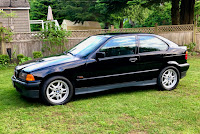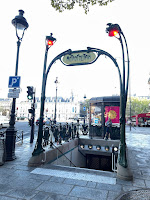Automotive
I'm starting a new category, as this doesn't seem to fit into the retirement or the travel section. I don't consider myself a "petrol-head", but I will admit that I probably was more into cars than most of my other friends and co-workers around me. I used to buy car magazines and look up every spec for the new hot cars, and I've probably watched every episode of Top Gear. But as I got older, it became less and less about how fast my car was, or how cool it looked, versus how much stuff could I carry, and or how practical the vehicle was. Oh how old I've gotten!
 |
| Then and now: back into a Hyundai hatch 39 years later |
Car and Driver also named it EV of the Year, and the British awarded it UK Car of the Year, both in 2022. (Update: Cars.com has awarded the Ioniq 5 Best EV of the Year for 2024, second year in a row, and The Car Connection named it the Best Electric Car To Buy for a second consecutive year). So in April of that year, we took a test drive in one, and naively put down our deposit, expecting to get notified in about a year that our car would be arriving. I won't bore you with the long, drawn-out details, but suffice it to say that demand for this model of EV far outstripped supply, and dealers were greedily taking upwards of $13,000 markup over MSRP from those who didn't want to wait in line. By June of 2023, I started to think that I'd never get one, but after stopping into Kamloops Hyundai, and shamelessly name dropping the previous owner of the dealership (a high school friend's husband), I was on a new list. So here we are now, about four months later, driving a car that is powered by water (BC is hydro-electric).
Timeline and history of cars
 |
| The EV 45 concept appeared in 2019 |
My little Pony
Unfortunately, with five kids all going every which way, my dad owned a fleet of cars. Not fancy cars, mind you, but lots of them, and in my teens, we had a few to choose from, depending on where you were going and what you were doing; e.g. the 1976 Cutlass Supreme with its 350 cubic inch V8 was a favourite for highway cruising. The last of these "fleet" cars that my dad bought, was a Hyundai Pony. By that time, all the other siblings had left home, so this one was effectively reserved for my use. With a whopping 74 bhp, it took my little pony about 15 seconds to get from 0 to 60. It was a terrible car in every sense of the word, and I vowed to never own another Hyundai.1976 Mercedes Benz 280S
This was my dad's car, and I loved it. As a kid growing up in Kamloops, a Mercedes was rare, and while this wasn't the coveted 450SL, it was still a Benz. I'd spend afternoons washing and polishing it, and this didn't go unnoticed. So when he retired, he gave me the big Benz. At over 1600 kgs and with only 156 bhp, it took almost 11 seconds to get from 0-60, but once you were up at highway speed, it was cruising! I got hooked by the level of quality and finish of the car, even if it was not the style for a 22-yr old. Unfortunately, it only lasted a year or so longer, before it lost a battle in Edmonton when an F250 ran a red light on a cold winter evening.1989 Mazda MX-6 GT 4WS
Armed with the insurance money from the Merc, and an 8.75% car loan, I sought out the best sporty car that I could afford. After reading the reviews in the car mags, this was it. The 4WS stands for four wheel steer, and at the time it was made, it was the fastest slalom production car in the world. 145 bhp propelled the MX-6 GT to 60 mph in 7.43 seconds; top speed was 209 km/h, but I seem to recall something faster? I’m surprised this thing didn’t kill me. This car was so rare, I had to scour the internet just for this picture. It was great for getting back and forth from Edmonton, but it was a cop magnet. But back then in Alberta, they only gave you points for speeding tickets, and when I moved back to Vancouver, I used a drivers licence swap to avoid having the points transfer across.1981 Toyota Landcruiser
This was part of the fleet that I mentioned earlier, and was our primary Tod Mountain ski vehicle. These Landcruisers were legendary, and we put many miles on that inline, 6-cylinder diesel engine. After my other brother Daryl graduated from university, he bought it from my dad, and after he was done with it, I was next in line. By then, it was rusting to pieces as they all did, so I got rid of the roof and doors and got it Maaco’ed. It was impractical as all get out, but a ton of fun at the time. You couldn't/didn't want to drive fast in this, and with only a bikini soft-top, it didn't work for weekend camping trips. I'd longed for having a 4x4 again, but without the roof, this wasn't practical enough, so when a guy came looking for a BJ40 to take him to the Baja, I sold it to him without regret.
1987 Toyota 4Runner
So I decided that I needed to trade 0-60 times for inches of ground clearance. I loved the Mazda, but it wasn’t great for camping, even worse for off-roading. What I really wanted was a Land Rover, but they were beyond my means. But the SUV was just starting to become a thing, and most manufacturers were coming out with something to try and keep up with the Jeep Cherokee market. Toyota basically took their legendary Hilux pickup truck and put in a second row of seats and topped it with a removable fibreglass shell. Well, you can take the boy out of Kamloops, but you can't take the Kamloops out of the boy; this truck was the key to reigniting my weekend camping and fishing adventures. The 4Runner was well sized for the city and excellent for these adventures, but with a wimpy 4-cylinder engine, it was perhaps a bit too underpowered?1997 Ford F-150 4x4
We're now just past the half way mark of the nineties, and I've taken a new sales role where I was paid a healthy car allowance, so my buddy David talked me into leasing the brand new Ford 1/2 ton. This was technically in 1996, when Ford released the new model design for their F150; it was an all-new design with much smoother, rounded lines than the predecessors. It had a 4.6 litre V8 that pumped out 220 bhp and 290 lb-ft of torque - plenty for what I needed. David had it fitted with huge BFG All-Terrain tires and a matching fibreglass canopy, so it was fantastic for my camping and fishing adventures. However, I found that it was too big for navigating around in Vancouver, so it went back at the end of the 2-yr lease.1997 Land Rover Discovery
The famous Land Rover, which became known as the Defender, was my dream 4x4, but for many reasons, too impractical (more on that here). However, they came out with the Disco, as they are affectionately called, and it was right in the middle of the Goldilocks zone for my purposes. It offered the best of both worlds; off-road adventures on the weekends, but cushy leather-wrapped commuting. Getting back into a European vehicle was also noticeable, as it had the feel of being in a solid German car like the Benz, but without the associated reliability. While BMW had bought Land Rover in 1994, it took them a number of years to incorporate their quality controls and measures; that meant that this model year was still very much a British-built car. Overweight and underpowered, this vehicle changed my driving style forever (well, almost).1967 Mercedes Benz 250SL
A little later on in the 90s, things were starting to heat up in the dot com space, and I had a little bit of extra cash kicking around; maybe an early mid-life crisis car was in order? A guy down the street had one of these when I was growing up in Kamloops and I’ve always coveted one. So I started watching the Buy & Sell and Autotrader for one of these to pop up; surprisingly back then, you could find two or three for sale at a given time. Some were projects asking for $9-10k, and others in the $15k range weren't the right colour. Then I stumbled onto this one, where the old guy had kept it in the garage for 6 years and only driven it 300 miles! I lowballed him at $13,500 - and he accepted it, but I wrestled with fuel issues for a few years and a few thousand dollars. With only 150 bhp, it yielded 0-60 times of... well, let's just say that the average soccer mom in her Toyota Sienna could take me off the line. I held onto the roadster (never put the hardtop on) for almost 20 years; when I noticed the value had gone up substantially, I decided it was time to part ways. It was the only car I really made money on.1987 Mercedes Benz 560SEC
Even though I had already filled the two parking spaces at my condo, there was another spot you could rent for a small fee. Besides, all my friends around me were having kids, so I decided that I needed a new baby of my own. Now this was a grand-touring car if there ever was one. Let's not forget that this was the flagship S-Class for Mercedes Benz; it had bells and whistles that other manufacturers hadn't even though of back then. One of my mates liked to call it the Yakuza-mobile, as this is the kind of car that the Japanese mafia liked back in the late 80s; at almost 1800 kgs, I preferred to call it “The Panzerwagen”. This Euro-spec version with 300 bhp was good for 0-60 in 6.6 seconds. Top speed? 250 km/h (unverified). But all that power and luxury was wasted commuting in Vancouver, and we had four cars at the time (hers a 1984 VW Jetta), so more practical minds eventually prevailed.2004 Land Rover Discovery II
 |
| Needed room for these two furballs |


































